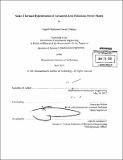| dc.contributor.advisor | Alexander Mitsos. | en_US |
| dc.contributor.author | El Khaja, Ragheb Mohamad Fawaz | en_US |
| dc.contributor.other | Massachusetts Institute of Technology. Dept. of Mechanical Engineering. | en_US |
| dc.date.accessioned | 2012-10-26T18:08:43Z | |
| dc.date.available | 2012-10-26T18:08:43Z | |
| dc.date.copyright | 2012 | en_US |
| dc.date.issued | 2012 | en_US |
| dc.identifier.uri | http://hdl.handle.net/1721.1/74434 | |
| dc.description | Thesis (S.B.)--Massachusetts Institute of Technology, Dept. of Mechanical Engineering, 2012. | en_US |
| dc.description | Cataloged from PDF version of thesis. | en_US |
| dc.description | Includes bibliographical references (p. 43-44). | en_US |
| dc.description.abstract | Carbon Dioxide emissions from power production are believed to have significant contributions to the greenhouse effect and global warming. Alternative energy resources, such as solar radiation, may help abate emissions but suffer from high costs of power production and temporal variations. On the other hand, Carbon Capture and Sequestration allows the continued use of fossil fuels without the CO2 emissions but it comes at an energetic penalty. The Advanced Zero Emissions Plant (AZEP) minimizes this energy loss by making use of Ion Transport Membrane (ITM)-based oxy-combustion to reduce the cost of carbon dioxide separation. This work seeks to assess if there are any thermodynamic gains from hybridizing solar-thermal energy with AZEP. The particular focus is hybridizing of the bottoming cycle with supplemental solar heating. A simple model of parabolic solar trough was used to hybridize a model of the AZEP cycle in ASPEN Plus*. Two cycle configurations are studied: the first uses solar parabolic troughs to indirectly vaporize high pressure steam through Therminol and the second uses parabolic troughs to directly preheat the high pressure water stream prior to vaporization. Simulations of the solar vaporizer hybrid by varying the total area of collectors (holding fuel input constant) show an increase of net electric output from 439MW for the non-hybridized AZEP to 533MW with an input solar share of 38.8%. The incremental solar efficiency is found to be around 16% for solar shares of input ranging from 5% to 38.8%. Moreover, simulations of variable solar insolation for collector area of 550,000 m2 , show that incremental solar efficiency increased with solar insolation reaching a plateau around 17%. Simulations of the direct solar preheater, show a net electric output of 501.3 MW for a solar share of 35%, (an incremental solar efficiency of 13.73%). The power generation and hence incremental efficiency is lower than in hybridization with steam vaporization with the same input solar share. Synergy analysis for the steam vaporization hybrid indicates no thermodynamic gains from hybridization. | en_US |
| dc.description.statementofresponsibility | by Ragheb Mohamad Fawaz El Khaja. | en_US |
| dc.format.extent | 44 p. | en_US |
| dc.language.iso | eng | en_US |
| dc.publisher | Massachusetts Institute of Technology | en_US |
| dc.rights | M.I.T. theses are protected by
copyright. They may be viewed from this source for any purpose, but
reproduction or distribution in any format is prohibited without written
permission. See provided URL for inquiries about permission. | en_US |
| dc.rights.uri | http://dspace.mit.edu/handle/1721.1/7582 | en_US |
| dc.subject | Mechanical Engineering. | en_US |
| dc.title | Solar-thermal hybridization of Advanced Zero Emissions Power Plants | en_US |
| dc.title.alternative | Solar-thermal hybridization of AZEP | en_US |
| dc.type | Thesis | en_US |
| dc.description.degree | S.B. | en_US |
| dc.contributor.department | Massachusetts Institute of Technology. Department of Mechanical Engineering | |
| dc.identifier.oclc | 813136345 | en_US |
